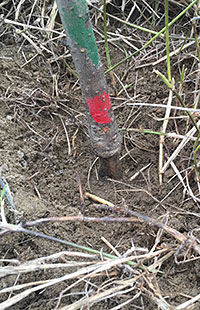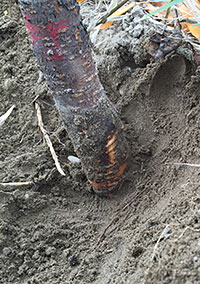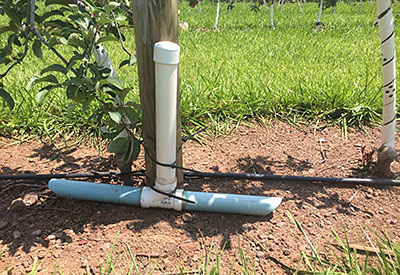Fact Sheet FS1293

Figure 1: Soil removed around the base of a dead peach tree showing a completely girdled trunk from vole feeding. (Photo Credit: Hemant Gohil)
Voles are a natural part of the orchard environment. They have a broad host range, and if provided with the ideal habitat and food, they may increase to damaging levels. Vole populations are normally cyclic and can reach high populations every 2-4 years. When vole density is high, then their feeding may result in significant tree damage. Vole populations in New Jersey orchards can be a serious problem if populations are not controlled, especially when combined with poor weed control. In problem years, high populations can lead to tree decline, or result in direct tree death.
Identification and Habitat
Voles are often confused with mice but are different species. Voles are small ground-dwelling rodents that occur throughout the northeast United States. Meadow voles (Microtus pennsylvanicus) and pine voles (Microtus pinetorum) are two common types of voles. Meadow voles are slightly larger than pine voles with a body 4.5 to 7 inches long, while pine voles grow up to 5 inches long. Pine voles have a tail that is a maximum 1 inch long, while a meadow vole tail is generally 1.5 to 2 inches long. Pine voles have small eyes and small almost inconspicuous ears, while meadow voles have larger eyes and ears. Though both types of voles can exist in the same orchard, there is a difference in terms of habitat preference. Meadow voles primarily feed in open vegetation as long as there is enough ground cover, while pine voles prefer to burrow systems just below the ground surface. Vole diets include many primary food sources such as seeds, bulbs, and tubers for pine voles, and seeds, grain, grasses, sedges, and insects for meadow voles. Both species can feed on fruit trees.
Damage

Figure 2: Soil removed around the base of a peach tree showing vole injury and gnawing marks, resulting in stunted growth. (Photo Credit: Hemant Gohil)
Most feeding damage occurs during the fall and winter months when other food sources are scarce but when tree trunks are easily accessible. Both types of voles can cause serious damage in orchards, especially to apple and peach trees. Meadow vole damage is often clearly visible at the ground surface in the form of girdling (Figure 1) or gnawing (Figure 2) at the base of the trunk. Pine vole damage is difficult to notice until the tree growth begins to decline by which time it is difficult to save the tree. Upon closer inspection, most pine vole damage will be seen as root damage and crown girdling under the ground surface. Sometimes feeding by either species may have occurred under a deep snow cover, when feeding and girdling can appear at the ground surface. This is often noticed the following spring.
Vole Monitoring
Species Identification
Identification of which vole species is causing damage helps target where most of the damage is likely to occur and can influence the placement of toxicant bait for control. Meadow voles create extensive surface runways, about 1.5 inches wide in the grass, which are often visible after close mowing. Bits of leaves and vole droppings in pathways are the surest signs of meadow vole presence. These runways are often spread out through the cover in orchard aisles and under poor weed control often cross back and forth to the tree row. Pine vole burrows and runways are just underground, but a "soft" feel of the soil under foot is one indication of pine vole presence.
To differentiate the species, place at least 20 traps in a 3-5 acre orchard block, close to tree trunks in active runs, heavily shaded areas, and in areas near woods borders. Make sure to cover each trap with something like a folded roofing shingle. Check the traps the next day, and identify the captured species. If the caught vole has a tail shorter than its hind leg, a pointy nose, sunken eyes, small ears, and brownish fur; it is a pine vole.
Predicting the Extent of Damage
The next step in controlling voles is to determine their population distribution and relative density with something like the ‘apple sign test’. The first step is to make a rough grid of the orchard and provide monitoring shelters that the voles can get accustomed to. These should be placed over or in runways near tree trunks, and can include shingles, PVC pipe, old pieces of sheet metal, or pieces of wood. Shelter placement should include orchard borders if close to woods and fields, as well as in the middle of the block. Distribute shelters at a rate of 15-20 per acre in orchards that are less than 5 acres, and 5-6 shelters per acre in larger orchards. These should be left alone for about a week before baiting with slices of apple. After baiting, check in 24 hours and record the stations that have chew marks on the apple pieces. This will tell you where to concentrate the use of toxicants. The percentage of gnawed pieces may also relate to the potential percentage of trees that can be attacked. Of course, noting the locations of dead and damaged trees is also an obvious indication of where controls should be concentrated.
Vole Management
Non-Toxicant

Figure 3: PVC pipe bait station placed in an orchard against a trellis post with zip ties.(Photo Credit: Dean Polk)
An integrated vole damage management program focuses on orchard floor management and physical barriers. Regularly mowing to a 3-5 inch ground cover not only limits the availability of food but also exposes voles to predators. Maintaining a vegetation-free zone within the tree row removes the shelter needed for runways and discourages voles from living close to the trunk. Sanitizing the orchard floor by removing leaves and pruned twigs which attract the voles is also helpful.
Good weed control is key to orchard vole management. Maintaining a minimum of 2 foot wide weed-free strip on either side of the tree will help prevent vole feeding, especially if meadow voles are present. Adding a 12-inch diameter, 3-4 inch deep gravel layer around the trunk prevents access to the trunk and tree crown, since gravel collapses in on a vole runway or burrow.
Cylinder-shaped wire guards made from ¼ inch mesh welded wire or hardware cloth placed around the tree trunks can protect trees. However, make sure to bury the hardware cloth at least 6 inches below the surface to control both meadow and pine voles. This exclusion method may not be very practical or cost effective in large orchards.
Toxicants
Combining chemical methods of control with good orchard floor management may be necessary with large vole populations. When vole populations get too high, trees decline and often die from voles feeding on the bark and girdling the trees. The use of toxicants within and near the herbicide strip in the tree rows is the most effective method to control high vole populations. There are two types of toxicants available: 1) a fast acting stomach poison (zinc phosphide) and 2) slow acting anticoagulants (chlorophacinone and diphacinone). Zinc phosphide is extremely toxic. Once eaten and in the stomach, it releases phosphine gas and zinc that disrupt cellular respiration and block protein synthesis, leading to rapid collapse of heart, liver, and lung functions. These materials are sold under a number of brand names including for Zinc Phosphide: Prozap Zinc Phosphide Pellets, Prozap Zinc Phosphide Oat Bait, Bonide Orchard Mouse Bait, and Zinc Phosphide Rodent Bait AG. All of these are formulated with 2% zinc phosphide. Anticoagulants include Ramik Oats, Ramik Brown, and Rozol Vole Bait. These are all from the Indandione class of anticoagulants. Do not confuse Ramik Brown with Ramik Green. Ramik Green can only be used indoors in bait stations or within 100 feet of structures.
The table below summarizes rodenticide materials that can be used for orchard vole control. The reliance on one product over another is discouraged, since voles will get accustomed to grain baits with anticoagulants or become bait shy of anticoagulants in general. Bait use is most effective when used in simple bait stations as previously outlined under "Monitoring". Hand placement in areas of high vole activity or depositing bait with a trail maker are also effective. Broadcast placement of toxicants is discouraged, since it is inefficient and can put nontarget wildlife and humans at high risk of poisoning. One reusable type of bait station can be made with 2-3" diameter PVC pipe. They can be made in either an 'L' or 'T' shape in which the horizontal pipe provides an opening for voles to enter, and the vertical section is for bait. The bait is released in small doses as it is consumed, permitting it to last a prolonged time and not weather. See instructions on the Missouri website extension.missouri.edu/p/G9445 and Figure 3.
A follow-up monitoring with the apple sign test should be repeated shortly after the use of toxicants to confirm control.
| Name | Mode of Action | Product Formulation | Comment |
|---|---|---|---|
| Zinc Phosphide | Stomach poison Fast acting, acutely toxic | Pellet or Grain | More effective against meadow voles. However when applied by coating an apple slice at 1 teaspoon per quart of water, it was effective to control pine voles. |
| Chlorophacinone | Anticoagulants Slow acting |
Pellet | More effective against pine voles. Weather resistant, hence can be used any season. Several applications at 3 week intervals may be required for effective control. |
| Diphacinone | Pellet or Grain |
*Make sure you have necessary pesticide applicator license to handle these chemicals.
Cautions for Other Non–Orchard Use Materials
Commercial fruit growers often contract with professional pest control companies for rodent control around packing houses and storage areas. These contractors often use rodenticides that are not labeled for orchard use. The same product classes are broadly available in garden and farm supply centers, and can be extremely toxic to pets and wildlife. They cannot be used, and are not labeled for orchard use, and shouldn't be confused with products that are labeled for orchard use. All of these must be used in and around buildings in tamper-resistant bait stations. The first group includes the "second generation" anticoagulants that contain Brodifacoum and Bromadiolone (e.g. Hawk Rodent Bait, Jaguar Rodent bait). The second group contains various formulations of Bromethalin, which is a nerve poison. The third group includes formulations of Cholecalciferol (Vitamin D3) or Cholecalciferon, which is a calcium mobilizer poison that is particularly effective for rodents.
Additional Sources
Mention or display of a trademark, proprietary product, or firm in text or figures does not constitute an endorsement by Rutgers Cooperative Extension and does not imply approval to the exclusion of other suitable products or firms.
May 2018
Copyright © 2025 Rutgers, The State University of New Jersey. All rights reserved.
For more information: njaes.rutgers.edu.
Cooperating Agencies: Rutgers, The State University of New Jersey, U.S. Department of Agriculture, and Boards of County Commissioners. Rutgers Cooperative Extension, a unit of the Rutgers New Jersey Agricultural Experiment Station, is an equal opportunity program provider and employer.

